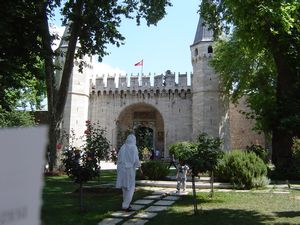Advertisement
Published: July 20th 2011

 Entrance to Topkapi Palace
Entrance to Topkapi Palace
Entering a world of wealth and power which lasted for centuries.We found ourselves in the Sultanahmet, the old section of Istanbul (Constantinople), full of amazing architecture going way back in time through many civilizations. In fact, Istanbul was first settled in 633 BC by the Dorics who founded the Byzantine empire.
We pronounced Sultanahmet in the English way, putting the stress on the second syllable, but soon discovered that its name came from Sultan Ahmed I, who, at 14 years of age, commissioned the Blue Mosque (also known as the Sultanahmet) to be built, so that's why it's pronounced in Turkey with the emphasis on the third syllable.
With a raft of attractions to visit, the question was where to start.
We decided to go first to Topkapi Palace, a mega complex of buildings covering a hilltop on the peninsula overlooking the Bosphorus, which is the strait which separates the city of Istanbul into its European and Asian sections.
High walls surround the palace, but they don't obstruct the magnificent and strategic views the palace dwellers had of the Marmara Sea and the trading ships and war vessals coming and going into the Golden Horn, the narrow ancient harbour below.
The buildings of the palace are

 Sultan's Reception Room
Sultan's Reception Room
Visitors were presented to the sultan in this building. It appears he greeted them from a large red plush platform with pillows. Whether any guests got invited onto the platform is a matter of speculation to me--we didn't pay for a guide that day.boggling in their splendour. Along with thousands of other visitors from around the world that day, we were awestruck as we went from one to the next and tried to imagine life in such a golden cage.
There were buildings for the various important offices of the realm, not least of which was the Treasury. Other important buildings were for receiving official visitors, for entertainment, for the memorializing of various war victories, and there is a special eminent building for the circumcision of the royal princes.
In certain areas photography was forbidden, but here are some snippets to gived you an idea.
The most popular part of the palace is the Harem (I am told this is pronounced hareem), where the
sultan's women lived. By the time we found it, we'd already been viewing exhibits for hours, it cost an additional entrance fee, and we were hot, footsore and weary, so we decided to leave it for another day.
When we left the Palace, we were beset upon by many people wishing to sell us something splendid. One man was sure Phil needed a fez for just 20 Turkish Lira. Phil said no. The man persisted.

 Entrance to Royal Treasury
Entrance to Royal Treasury
The people in charge of the treasury were luxuriously accommodated.I said no on Phil's behalf and hurried onward. But when I turned around, I saw Phil approaching wearing a purple faz!
"I thought you didn't want that," I said.
"He offered me a price I couldn't refuse," said Phil, who never wears anything which calls attention to himself. But who also likes to get things CHEAP.
"How much?" I asked.
"Fifteen Lira, finally 10."
So then, like flies to honey, Phil's fez being a sort of neon "Chump" sign, there was an endless stream of people who could sell us carpets, ceramics, ice cream, postcards, tours, evil eye amulets, figurines, statues of mosques, deep fried corn on the cob, roasted chestnuts, Dervish dolls that actually whirled...
We came to admire the adept business sense of the energetic and enthusiastic salesmen, who used tried-and-true innocent-sounding opening lines which stopped us many times, like "What are you looking for?" or "Where are you from?" or "Are you from Australia?" -- and if we said yes to that they would immediately smile and say some magic word like "vegemite!" or "Aussie!" or "Oy!" And the next line was usually the reassurance, "I am not a guide."
But it was almost certain he was a carpet salesman or had a ceramics shop or a very nice lunch to offer.
And the carpets and ceramics and lunches WERE nice, exquisite sometimes. Phil continually reminded me that we were backpacking and where would I PUT a carpet or how could I carry ceramics and not break them. But lunches we could have.
We're hoping we don't each end up with a paunch from all the good food here. Locally, this is referred to as a "Turkish balcony".
Advertisement
Tot: 0.094s; Tpl: 0.012s; cc: 11; qc: 25; dbt: 0.0655s; 1; m:domysql w:travelblog (10.17.0.13); sld: 1;
; mem: 1mb

 Entrance to Topkapi Palace
Entrance to Topkapi Palace
 Sultan's Reception Room
Sultan's Reception Room
 Entrance to Royal Treasury
Entrance to Royal Treasury







Gabrielle
non-member comment
deja vu
Thanks for giving me a very pleasant flashback experience Martha and link to my last visit there in about 1982/83. I would have bought a new carpet to replace the one my son recenly threw away that I bought there then. I do love your story about Phil buying the fez - it's so not Phil!!